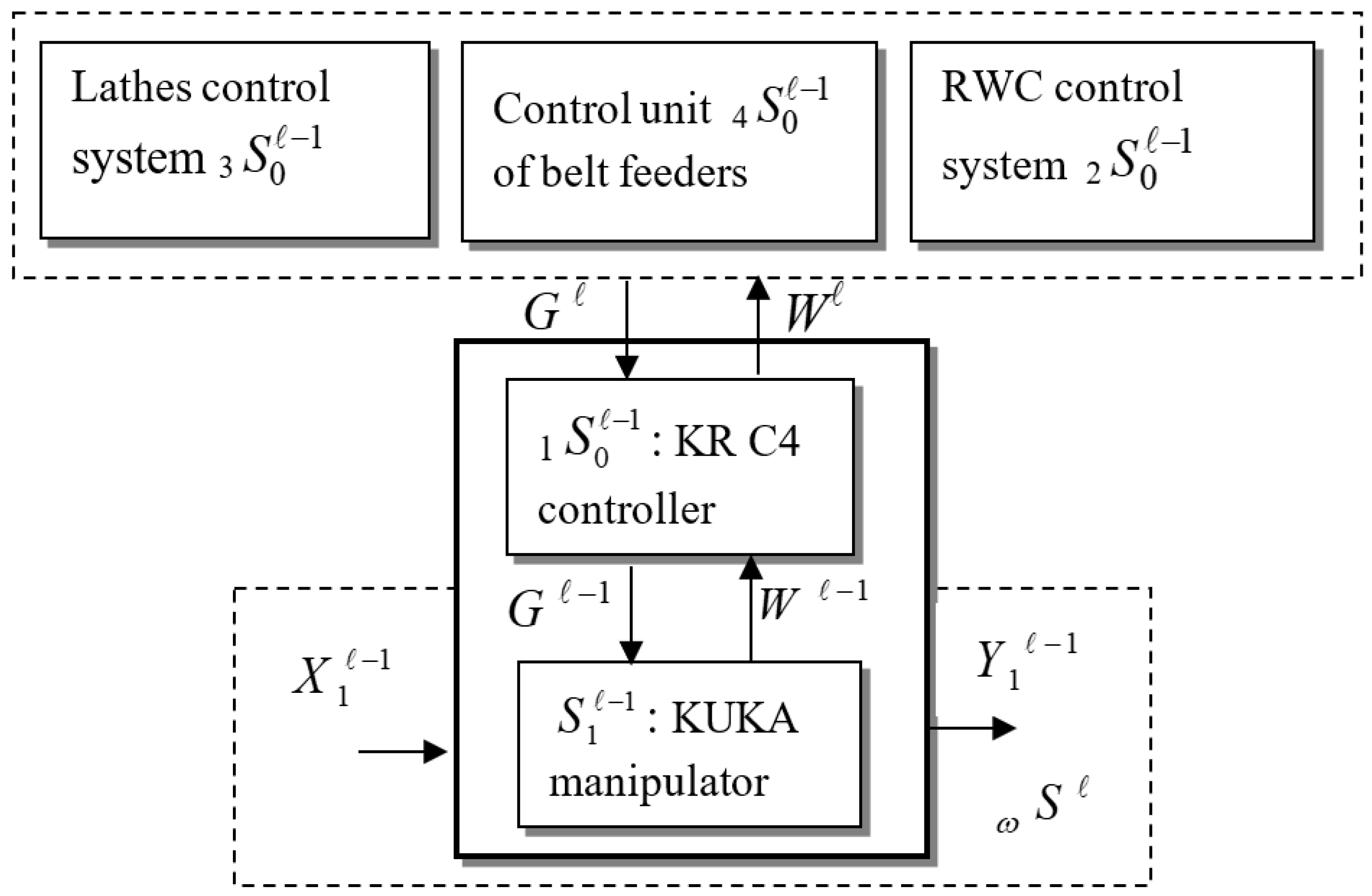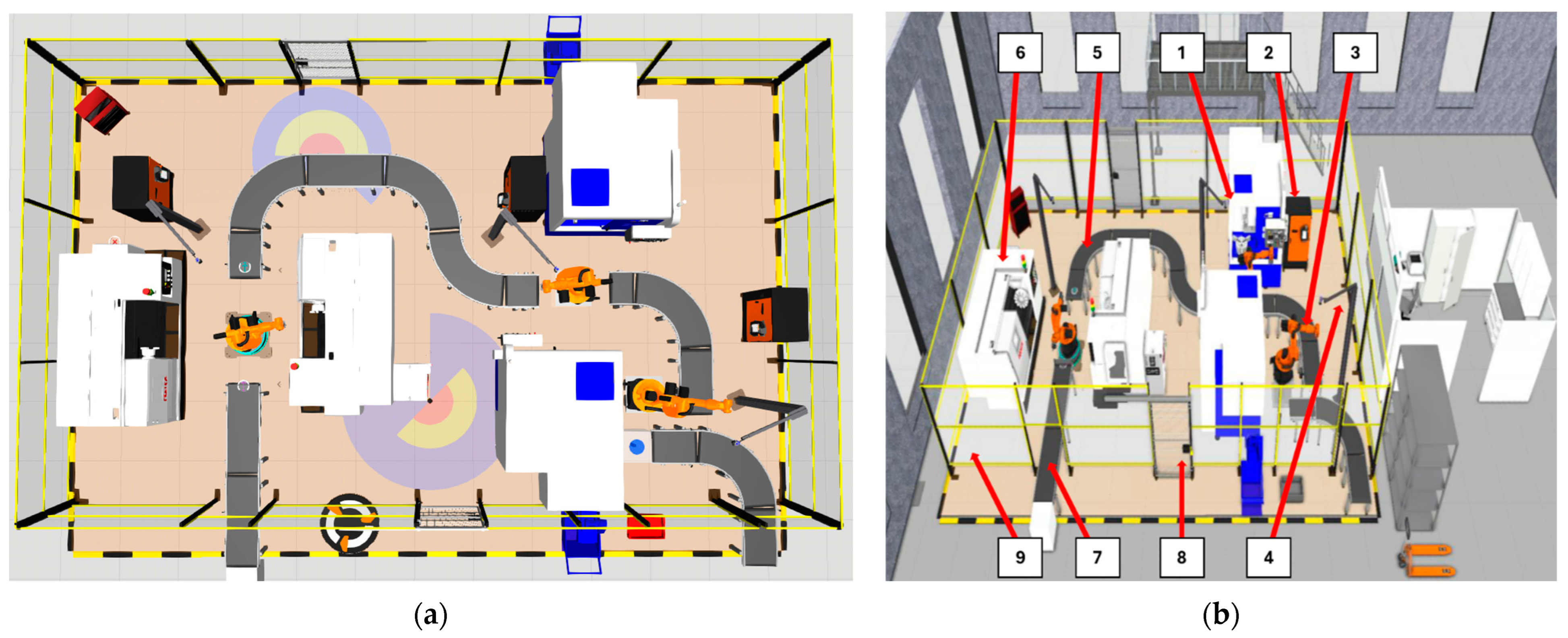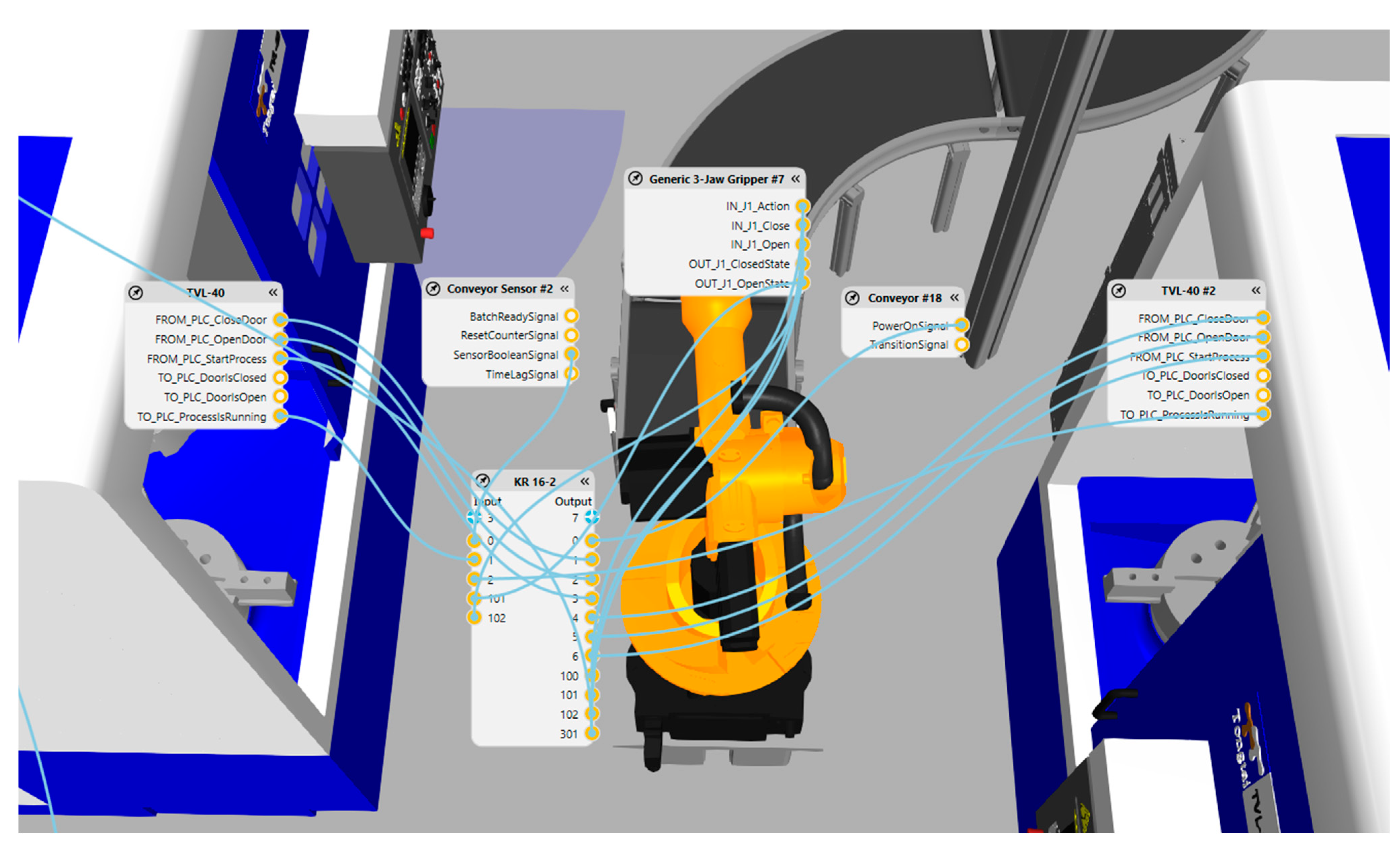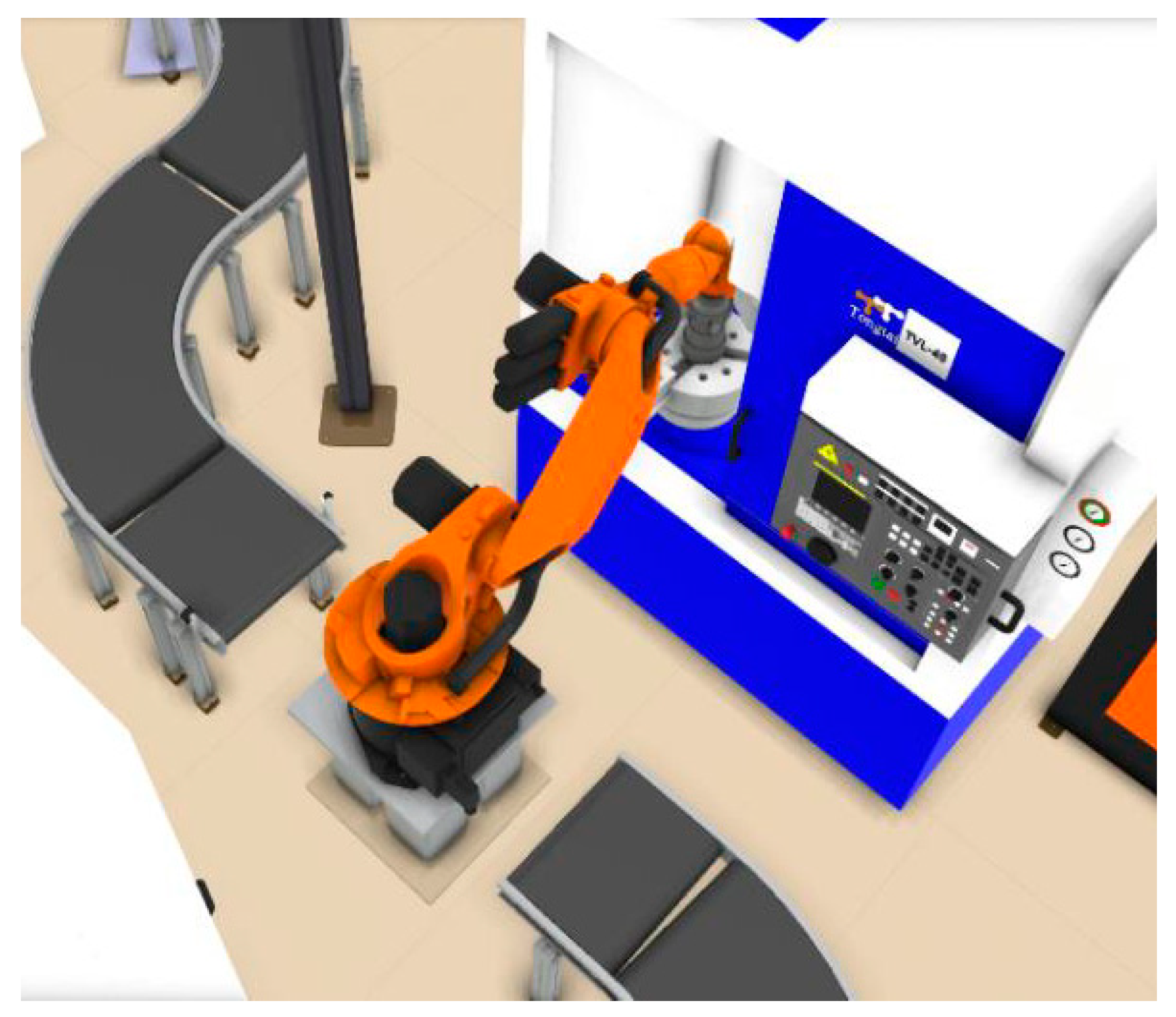Design of a Robotic Work Cell Using Hierarchical Systems Approach and Visual Components Software
Abstract
:1. Introduction
2. Materials and Methods
2.1. Conceptual Model Creation
2.1.1. Robotic Work Cell Conceptual Model
- : robot system (RS);
- : control system (CS);
- : CNC machines (CM);
- : surveillance cameras (SC);
- : belt feeders (BF).
2.1.2. RWC Coordinator Control Processes
- (1)
- robot control ;
- (2)
- RWC control processes integration ;
- (3)
- CNC machines control ;
- (4)
- surveillance cameras and belt feeders control .
2.2. Development of a Digital Model of a Robotic Work Cell
2.2.1. Creation of the RWC Prototypes
2.2.2. Resultant Work Cell Design
- 1 TongTai TVL-40 CNC lathe, two machines used.
- KR C4 controller (3 units used) and RWC control systems.
- Robot KUKA KR16-2 F, three robots used.
- Surveillance cameras, three units used.
- Curved belt feeders, five feeders used.
- 2 CNC lathe Feeler FTC-350, two machines used.
- Straight belt feeders, nine feeders used.
- Automatically locking doors, two doors installed.
- Barriers around work cell.
2.2.3. Work Cell Components Selection
2.2.4. Implementation of the RWC Components Connections
2.2.5. Processes Performed by RWC
2.2.6. KUKA Robot Motion Control in a Laboratory Environment
3. Results and Discussion
4. Conclusions
Author Contributions
Funding
Data Availability Statement
Acknowledgments
Conflicts of Interest
References
- Visual Components. Available online: https://www.visualcomponents.com/resources/blog/introducing-visual-components-4-4/ (accessed on 11 February 2025).
- Pokojski, J.; Szustakiewicz, K. Towards an aided process of building a knowledge based engineering applications. Mach. Dyn. Probl. 2009, 33, 91–100. [Google Scholar]
- Mele, M.; Campana, G. A new method for the design of knowledge-based engineering systems for manufacturing. Int. J. Interact. Des. Manuf. 2021, 15, 417–428. [Google Scholar] [CrossRef]
- Sobieszczanski-Sobieski, J.; Morris, A.; Tooren, M. Multidisciplinary Design Optimization Supported by Knowledge Based Engineering; John Wiley & Sons: Hoboken, NJ, USA, 2015. [Google Scholar]
- Papiernik, K.; Grabska, E.; Borkowski, A. On applying model-driven engineering to conceptual design. Mach. Dyn. Probl. 2007, 31, 58–65. [Google Scholar]
- Casalaro, G.L.; Cattivera, G.; Ciccozzi, F.; Malavolta, I.; Wortmann, A.; Pelliccione, P. Model-driven engineering for mobile robotic systems: A systematic mapping study. Softw. Syst. Model. 2022, 21, 19–49. [Google Scholar] [CrossRef]
- Bryant, C.R.; Stone, R.B.; McAdams, D.A.; Kurtoglu, T.; Campbell, M.I. Concept generation from the functional basis of design. In Proceedings of the International Conference on Engineering Design (ICED 2005), Melbourne, Australia, 15–18 August 2005. [Google Scholar]
- Valjak, F.; Nenad Bojčetić, N. Functional modelling through Function Class Method: A case from DfAM domain. Alex. Eng. J. 2023, 66, 191–209. [Google Scholar] [CrossRef]
- Gero, J.S.; Kannengiesser, U. A function–behavior–structure ontology of processes. Artif. Intell. Eng. Des. Anal. Manuf. 2007, 21, 379–391. [Google Scholar] [CrossRef]
- Al-Fedaghi, S. Function-Behavior-Structure model of design: An alternative approach. Int. J. Adv. Comput. Sci. Appl. 2016, 7, 133–139. [Google Scholar] [CrossRef]
- Gausemeier, J.; Ramming, F.J.; Schafer, W. Design Methodology for Intelligent Technical Systems; Springer: Berlin/Heidelberg, Germany, 2014. [Google Scholar]
- Kühn, A.; Dumitrescu, R.; Gausemeier, J. Managing evolution from mechatronics to intelligent technical systems. J. Technol. 2015, 76, 13–18. [Google Scholar] [CrossRef]
- Legatiuk, D.; Nilsson, H. Abstract modelling: Towards a typed declarative language for the conceptual modelling phase. In Proceedings of the 8th International Workshop on Equation-Based Object-Oriented Modeling Languages and Tools, Munich, Germany, 1 December 2017; pp. 61–64. [Google Scholar]
- Miatliuk, K. Conceptual Design of Mechatronic Systems; WPB: Bialystok, Poland, 2017; Available online: https://pb.edu.pl/oficyna-wydawnicza/wp-content/uploads/sites/4/2018/02/Miatluk_publikacja.pdf (accessed on 11 February 2025).
- Miatliuk, K.; Kim, Y.H.; Kim, K.; Siemieniako, F. Use of Hierarchical System Technology in Mechatronic Design. J. Mechatron. 2010, 20, 335–339. [Google Scholar] [CrossRef]
- Miatliuk, K. Conceptual Model in the Formal Basis of Hierarchical Systems for Mechatronic Design. J. Cybern. Syst. 2015, 46, 666–680. [Google Scholar] [CrossRef]
- Miatluk, K.; Nawrocka, A.; Holewa, K.; Moulianitis, V. Conceptual Design of BCI for Mobile Robot Control. Appl. Sci. 2020, 10, 2557. [Google Scholar] [CrossRef]
- Miatliuk, K.; Wolniakowski, A.; Trochimczuk, R.; Jorgensen, J. Mechatronic Design and Control of a Robot System for Grinding. In Proceedings of the 20th IEEE/ASME International Conference on Mechatronic and Embedded Systems and Applications, Genova, Italy, 2–4 September 2024; pp. 1–6. [Google Scholar]
- Miatliuk, K.; Wolniakowski, A.; Quintana, J.J. Conceptual Design and Control of a Robotic System for Welding. In Proceedings of the 24th IEEE International Carpathian Control Conference, Miskolc-Szilvásvárad, Hungary, 12–14 June 2023; pp. 279–284. [Google Scholar]
- RobotStudio. Available online: https://new.abb.com/products/robotics/robotstudio (accessed on 11 February 2025).
- CoppeliaSim. Available online: https://www.coppeliarobotics.com/ (accessed on 11 February 2025).
- DELMIA. Available online: https://www.cadsol.pl/produkty/delmia/ (accessed on 11 February 2025).
- RoboDK. Available online: https://robodk.com/ (accessed on 11 February 2025).
- Archila, J.F.; Dutra, M.S.; Castro Pinto, F.A. Kinematical and Dynamical Models of KR 6 KUKA Robot, Including the Kinematic Control in a Parallel Processing Platform. In Robot Manipulators, New Achievements; IntechOpen: Rijeka, Croatia, 2010; pp. 601–620. [Google Scholar]
- TongTai. Available online: https://www.tongtai.com.tw/en/product-detail.php?id=138 (accessed on 11 February 2025).
- KUKA. Available online: https://www.robots.com/images/robots/KUKA/Low-Payload/KUKA_KR_16_2_F_Datasheet.pdf (accessed on 11 February 2025).
- Miatliuk, K.; Wolniakowski, A.; Kolosowski, P. Engineering system of systems conceptual design in theoretical basis of hierarchical systems. In Proceedings of the IEEE International Conference Systems Man and Cybernetics SMC, Toronto, ON, Canada, 11–14 October 2020; pp. 2850–2856. [Google Scholar]
- Wolniakowski, A.; Miatliuk, K.; Kruger, N.; Petersen, H.; Ritz, J. Task and context sensitive gripper design learning using dynamic grasp simulation. J. Intell. Robot. Syst. 2017, 87, 15–42. [Google Scholar] [CrossRef]
- Valsamos, C.; Miatluk, K.; Wolniakowski, A.; Moulianitis, V.; Aspragathos, N. Optimal kinematic task position determination–application and experimental verification for the UR5 manipulator. Appl. Sci. 2022, 12, 9352. [Google Scholar] [CrossRef]
- Diaz, M.; Ferrer, M.A.; Quintana, J.J.; Miatliuk, K.; Wolniakowski, A.; Vessio, G.; Trochimczuk, R.; Castellano, G. Neural network modelling of kinematic and dynamic features for signature verification. Pattern Recognit. Lett. 2025, 187, 130–136. [Google Scholar] [CrossRef]
- Trochimczuk, R.; Wolniakowski, A.; Cheng, Z.; Romaniuk, S.; Tomaszewski, R. Overview of selected teleoperation positioning systems for controlling a robot arm operating in Remote Centre of Motion (RCM) mode. In Proceedings of the 28th IEEE International Conference on Methods and Models in Automation and Robotics, Miedzyzdroje, Poland, 27–30 August 2024; pp. 253–258. [Google Scholar]
- Dimeas, F.; Sako, D.; Moulianitis, V.; Aspragathos, N. Design and fuzzy control of a robotic gripper for efficient strawberry harvesting. Robotica 2015, 33, 1085–1098. [Google Scholar] [CrossRef]
- Mystkowski, A.; Wolniakowski, A.; Idzkowski, A.; Ciezkowski, M.; Ostaszewski, M.; Kociszewski, R.; Kotowski, A.; Kulesza, Z.; Dobrzański, S.; Miastkowski, K. Measurement and diagnostic system for detecting and classifying faults in the rotary hay tedder using multilayer perceptron neural networks. Eng. Appl. Artif. Intell. 2024, 133, 108513. [Google Scholar] [CrossRef]
- János Simon, J.; Gogolák, L.; Sárosi, J. Deep Reinforcement Learning-Assisted Teaching Strategy for Industrial Robot Manipulator. Appl. Sci. 2024, 14, 10929. [Google Scholar] [CrossRef]












| N | Qualities | Proposed Method | Other Methods |
|---|---|---|---|
| 1 | Formalization | Yes | No |
| 2 | Coordinator | Yes | No |
| 3 | Connected models of system structure, dynamics and environment | Yes | No |
| 4 | Agreement with models of classic mathematics and AI | Yes | No |
| 5 | Geometric information representation | Yes | Partially |
Disclaimer/Publisher’s Note: The statements, opinions and data contained in all publications are solely those of the individual author(s) and contributor(s) and not of MDPI and/or the editor(s). MDPI and/or the editor(s) disclaim responsibility for any injury to people or property resulting from any ideas, methods, instructions or products referred to in the content. |
© 2025 by the authors. Licensee MDPI, Basel, Switzerland. This article is an open access article distributed under the terms and conditions of the Creative Commons Attribution (CC BY) license (https://creativecommons.org/licenses/by/4.0/).
Share and Cite
Miatliuk, K.; Koc, K.; Eliacik, A.; Miyagi, P.E.; Pessoa, M.A.O. Design of a Robotic Work Cell Using Hierarchical Systems Approach and Visual Components Software. Appl. Sci. 2025, 15, 4744. https://doi.org/10.3390/app15094744
Miatliuk K, Koc K, Eliacik A, Miyagi PE, Pessoa MAO. Design of a Robotic Work Cell Using Hierarchical Systems Approach and Visual Components Software. Applied Sciences. 2025; 15(9):4744. https://doi.org/10.3390/app15094744
Chicago/Turabian StyleMiatliuk, Kanstantsin, Krystian Koc, Atakan Eliacik, Paulo E. Miyagi, and Marcosiris A. O. Pessoa. 2025. "Design of a Robotic Work Cell Using Hierarchical Systems Approach and Visual Components Software" Applied Sciences 15, no. 9: 4744. https://doi.org/10.3390/app15094744
APA StyleMiatliuk, K., Koc, K., Eliacik, A., Miyagi, P. E., & Pessoa, M. A. O. (2025). Design of a Robotic Work Cell Using Hierarchical Systems Approach and Visual Components Software. Applied Sciences, 15(9), 4744. https://doi.org/10.3390/app15094744








